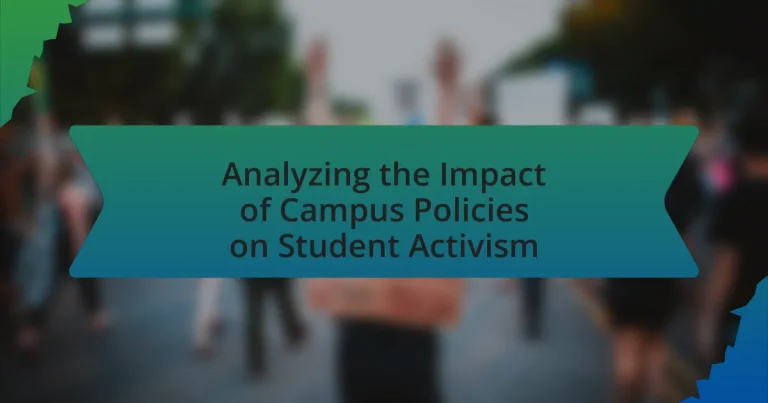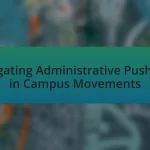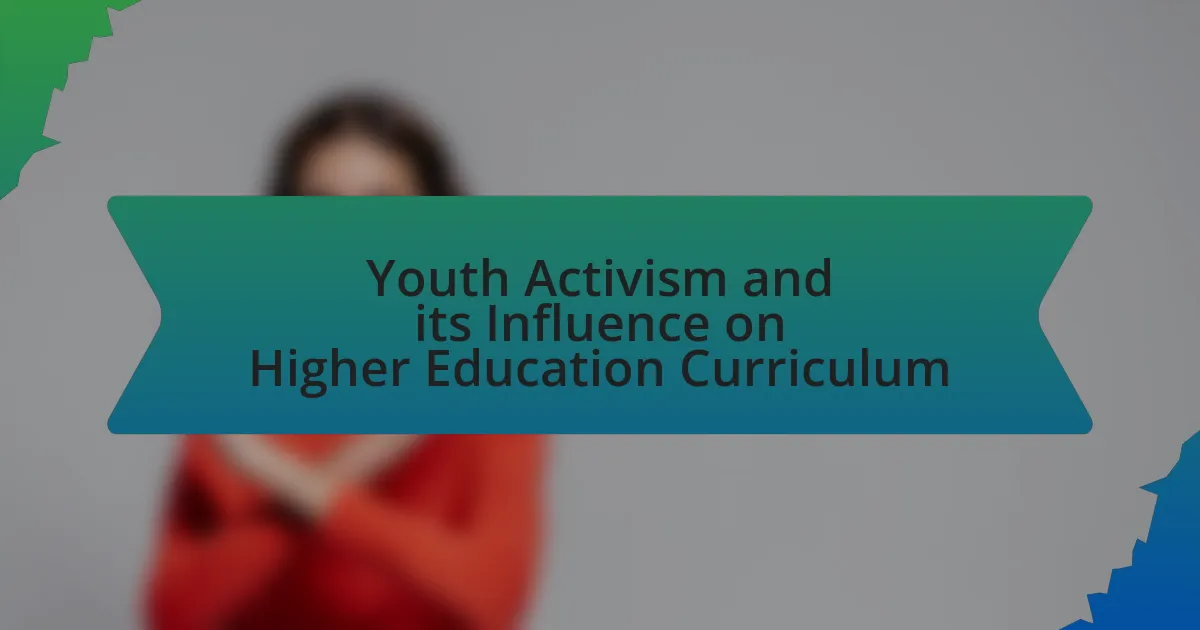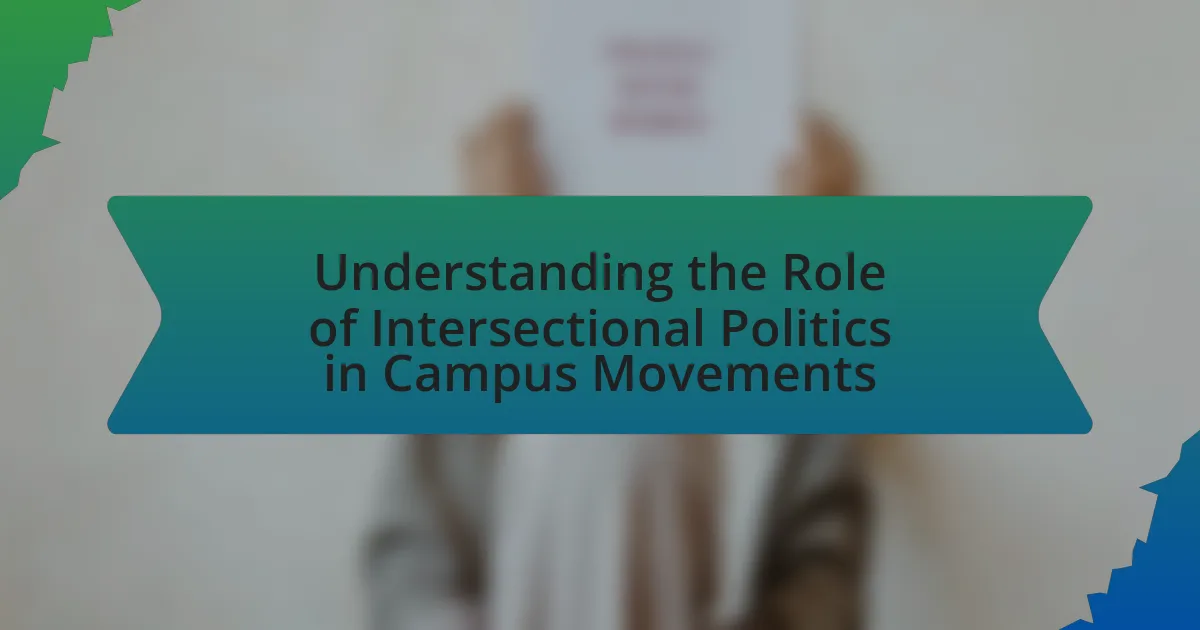The article analyzes the impact of campus policies on student activism, highlighting how formal guidelines established by educational institutions influence student behavior, rights, and responsibilities. It discusses the role of policies related to free speech, assembly, and protest in either facilitating or hindering activism efforts. The article also examines the historical context that shapes current policies, the challenges activists face due to restrictive regulations, and the positive effects of supportive policies on engagement. Additionally, it outlines strategies for students to navigate and influence these policies, emphasizing the importance of collaboration with administration and best practices for effective activism.
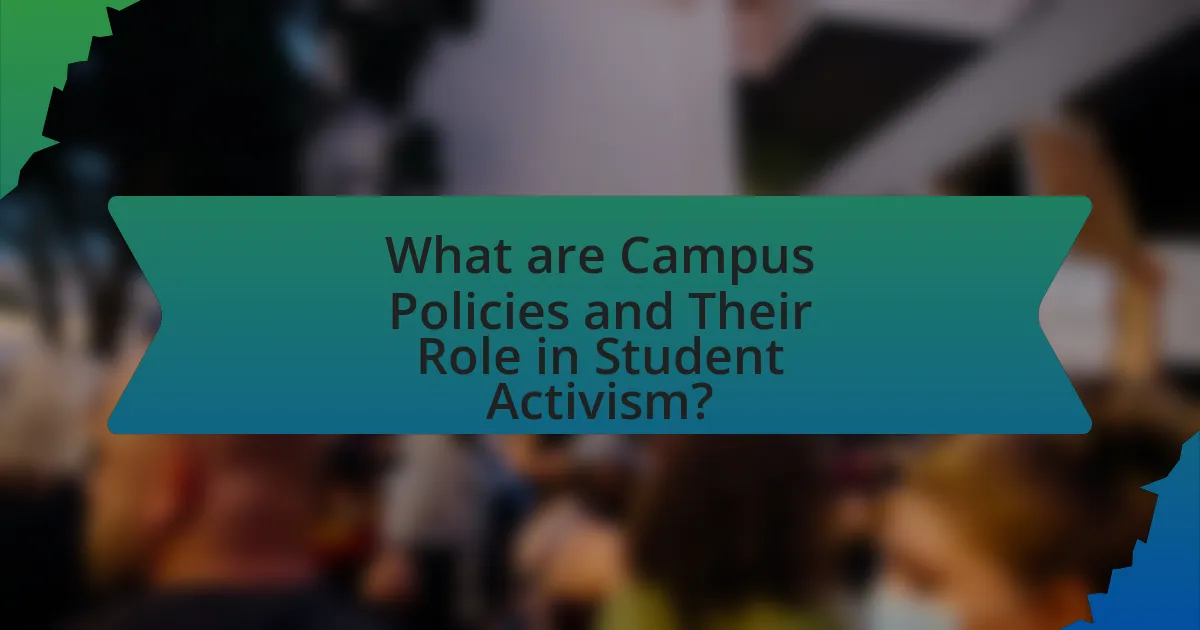
What are Campus Policies and Their Role in Student Activism?
Campus policies are formal guidelines established by educational institutions that govern student behavior, rights, and responsibilities. These policies play a crucial role in student activism by either facilitating or hindering students’ ability to organize, express dissent, and advocate for change. For instance, policies regarding free speech, assembly, and protest can significantly influence the effectiveness of student-led movements. Research indicates that campuses with supportive policies tend to experience higher levels of student engagement in activism, as seen in the 2017 study by the American Association of University Professors, which found that institutions promoting free expression fostered a more vibrant activist culture.
How do campus policies influence student activism?
Campus policies significantly influence student activism by shaping the environment in which students organize and express their views. Policies that promote free speech and assembly encourage students to engage in activism, while restrictive policies can suppress their efforts. For instance, universities with clear guidelines supporting student protests and demonstrations often see higher levels of student participation in activism, as evidenced by the increased mobilization during movements like Black Lives Matter on campuses with supportive policies. Conversely, institutions that impose strict regulations on gatherings or require permits can deter students from organizing, leading to lower levels of activism. This relationship highlights how the framework established by campus policies directly affects the vibrancy and effectiveness of student-led initiatives.
What types of campus policies are most relevant to student activism?
Campus policies most relevant to student activism include free speech policies, student organization regulations, and protest guidelines. Free speech policies dictate the extent to which students can express their views on campus, influencing the ability to organize and participate in activism. Student organization regulations determine how groups can form, receive funding, and operate, directly impacting the mobilization of activist efforts. Protest guidelines outline the rules for demonstrations, affecting the methods and locations available for activism. These policies shape the environment in which student activism occurs, as evidenced by various campus incidents where restrictions on speech or assembly have sparked significant student responses.
How do these policies shape the environment for activism?
Campus policies significantly shape the environment for activism by establishing the rules and frameworks within which students can organize and express their views. For instance, policies that promote free speech and assembly create a supportive atmosphere for activism, allowing students to engage in protests and discussions without fear of retribution. Conversely, restrictive policies, such as those limiting the use of campus spaces or imposing strict regulations on demonstrations, can stifle student activism by making it more difficult for students to mobilize and communicate their messages. Research indicates that campuses with more inclusive policies see higher levels of student engagement in activism, as evidenced by increased participation in events and initiatives aimed at social change.
Why is understanding campus policies important for student activists?
Understanding campus policies is crucial for student activists because these regulations dictate the framework within which they can operate. Knowledge of policies such as free speech rights, protest regulations, and organizational guidelines enables activists to effectively plan and execute their initiatives without facing legal repercussions. For instance, the First Amendment protects students’ rights to free speech on public campuses, but specific policies may outline the designated areas for protests or the need for permits. By being informed, student activists can navigate these rules to maximize their impact while minimizing the risk of disciplinary actions or conflicts with administration.
What challenges do activists face due to campus policies?
Activists face significant challenges due to campus policies that often restrict free speech and limit the ability to organize events. These policies can include stringent regulations on the use of campus spaces, requiring permits for demonstrations, and imposing time, place, and manner restrictions that hinder spontaneous activism. For instance, a study by the Foundation for Individual Rights in Education (FIRE) found that 37% of colleges maintain policies that significantly restrict student expression, which can stifle activism and discourage participation in social movements. Additionally, disciplinary actions against students for protesting or expressing dissenting views can create a chilling effect, discouraging others from engaging in activism.
How can knowledge of policies empower student activists?
Knowledge of policies empowers student activists by providing them with the necessary framework to advocate effectively for their rights and interests. Understanding institutional policies enables activists to identify areas where change is needed, articulate their demands clearly, and navigate the bureaucratic processes involved in enacting those changes. For instance, familiarity with Title IX regulations allows student activists to address issues of sexual harassment and discrimination on campus, as they can leverage these policies to hold institutions accountable. Additionally, knowledge of free speech policies equips activists to defend their right to protest and express dissenting opinions, ensuring that their voices are heard in the campus dialogue.
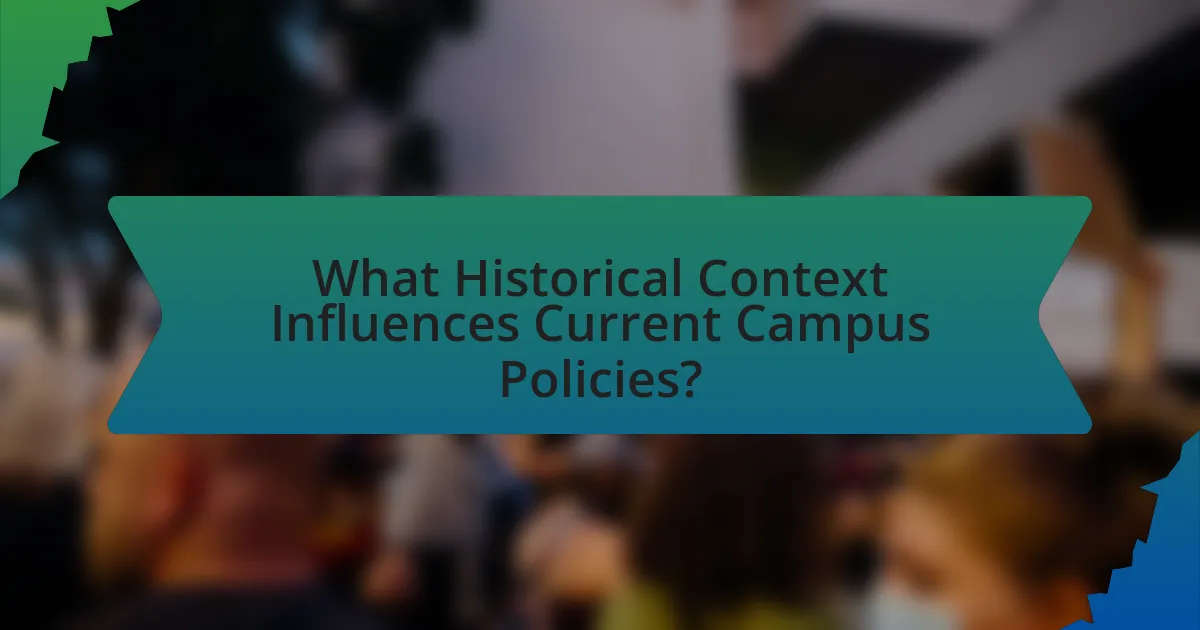
What Historical Context Influences Current Campus Policies?
Current campus policies are influenced by historical contexts such as the civil rights movement, the anti-war protests of the 1960s, and Title IX legislation. The civil rights movement led to increased awareness and advocacy for equality and inclusion on campuses, prompting policies that address discrimination and promote diversity. The anti-war protests highlighted the importance of free speech and student activism, resulting in policies that protect students’ rights to express dissent. Title IX, enacted in 1972, established federal regulations against gender discrimination in education, shaping policies related to sexual harassment and equity in athletics. These historical events collectively inform contemporary campus policies, emphasizing the need for inclusivity, free expression, and protection against discrimination.
How have historical events shaped campus policies today?
Historical events have significantly influenced campus policies today by prompting institutions to adopt regulations that address social justice, diversity, and student rights. For instance, the civil rights movement of the 1960s led universities to implement policies promoting racial equality and inclusion, resulting in affirmative action programs and anti-discrimination laws. Additionally, the protests against the Vietnam War in the late 1960s prompted many campuses to establish policies that protect free speech and student activism, ensuring that students can express their views without fear of retribution. These historical precedents have shaped contemporary campus environments, fostering a culture that values student engagement and activism while addressing systemic inequalities.
What significant movements have impacted policy changes?
Significant movements that have impacted policy changes include the Civil Rights Movement, the Women’s Liberation Movement, and the Rights Movement. The Civil Rights Movement, particularly in the 1960s, led to landmark legislation such as the Civil Rights Act of 1964, which prohibited discrimination based on race, color, religion, sex, or national origin. The Women’s Liberation Movement resulted in policies like Title IX of the Education Amendments of 1972, which prohibits sex-based discrimination in federally funded education programs. The Rights Movement has influenced policies such as the repeal of “Don’t Ask, Don’t Tell” in 2010 and the legalization of same-sex marriage in the U.S. through the Supreme Court’s decision in Obergefell v. Hodges in 2015. These movements have collectively shaped social and legal frameworks, demonstrating the power of activism in driving policy change.
How do past policies inform current student activism strategies?
Past policies shape current student activism strategies by providing a historical context that informs tactics, goals, and organizational structures. For instance, the civil rights movement’s emphasis on nonviolent protest has influenced contemporary student movements, such as Black Lives Matter on campuses, which adopt similar methods to advocate for racial justice. Additionally, policies like Title IX have led to increased activism around sexual assault awareness and prevention, as students mobilize to demand accountability and reform in their institutions. Historical successes and failures of past movements serve as case studies, guiding current activists in their approaches to coalition-building, messaging, and engagement with administration.
What role do administrative decisions play in shaping policies?
Administrative decisions are crucial in shaping policies as they determine the framework and guidelines that govern institutional operations. These decisions influence the allocation of resources, the establishment of rules, and the prioritization of issues, which directly affect how policies are formulated and implemented. For instance, a university’s administrative decision to prioritize mental health resources can lead to the development of supportive policies that enhance student well-being and activism. This connection between administrative choices and policy outcomes illustrates the significant role that leadership plays in addressing student needs and fostering an environment conducive to activism.
How do administrative priorities affect student activism?
Administrative priorities significantly influence student activism by shaping the environment in which students organize and advocate for change. When university administrations prioritize issues such as diversity, equity, and inclusion, they often create platforms and resources that empower student voices, leading to increased activism around these topics. Conversely, if administrations focus on maintaining institutional stability or financial concerns, they may suppress dissent or limit student engagement, resulting in a decline in activism. For example, a study by the American Association of University Professors found that campuses with supportive administrative policies saw a 30% increase in student-led initiatives compared to those with restrictive policies. This demonstrates that the alignment of administrative priorities with student interests can either foster or hinder activism.
What processes are involved in policy formulation on campuses?
The processes involved in policy formulation on campuses include problem identification, stakeholder engagement, research and analysis, drafting policy proposals, consultation, and implementation. Problem identification occurs when issues affecting the campus community are recognized, prompting the need for policy development. Stakeholder engagement involves gathering input from students, faculty, administration, and other relevant parties to ensure diverse perspectives are considered. Research and analysis provide evidence-based insights that inform policy decisions, often utilizing data from surveys or academic studies. Drafting policy proposals translates the gathered information into actionable guidelines. Consultation allows for feedback on the proposals, ensuring they address the needs of the community effectively. Finally, implementation involves putting the approved policies into practice, often accompanied by evaluation mechanisms to assess their impact. These processes are essential for creating effective campus policies that respond to the needs of students and the institution.
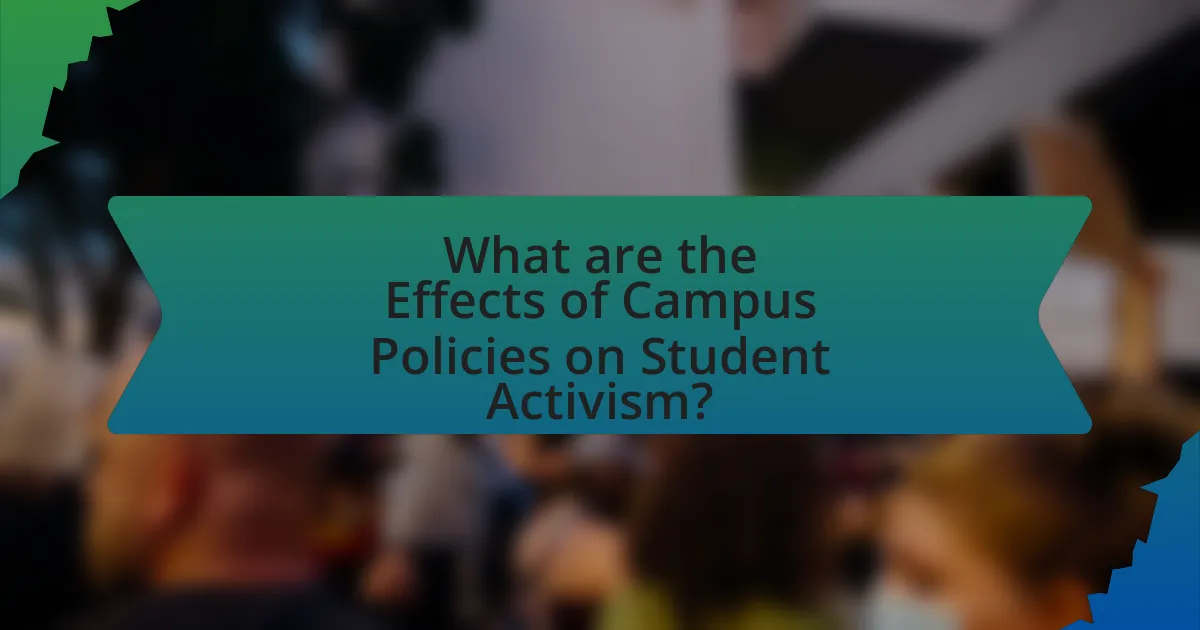
What are the Effects of Campus Policies on Student Activism?
Campus policies significantly influence student activism by either facilitating or constraining students’ ability to organize and express their views. For instance, policies that promote free speech and allow for open forums encourage student engagement and activism, as seen in universities that have implemented inclusive policies, leading to increased participation in protests and discussions. Conversely, restrictive policies, such as those limiting gathering sizes or requiring permits for demonstrations, can suppress activism, as evidenced by studies showing a decline in organized protests in institutions with stringent regulations. Thus, the nature of campus policies directly correlates with the level of student activism, shaping the environment in which students operate.
How do restrictive policies impact student activism efforts?
Restrictive policies significantly hinder student activism efforts by limiting the avenues through which students can express their views and organize. These policies often impose regulations on gatherings, speech, and distribution of materials, which directly stifles the ability of students to mobilize for causes. For instance, a study by the Foundation for Individual Rights in Education (FIRE) found that 37% of colleges have policies that restrict student speech, which can lead to decreased participation in activism and a chilling effect on free expression. Such limitations not only reduce the visibility of student movements but also discourage students from engaging in activism due to fear of repercussions.
What are the consequences of censorship on campus activism?
Censorship on campus activism leads to diminished student engagement and stifled discourse. When universities impose restrictions on speech or limit the expression of certain viewpoints, students may feel discouraged from participating in activism, fearing repercussions or marginalization. Research indicates that such censorship can result in a lack of diverse perspectives, which is essential for a healthy academic environment. For instance, a study by the Foundation for Individual Rights in Education (FIRE) found that 80% of students reported self-censoring their views due to fear of backlash, ultimately undermining the vibrancy of campus life and the effectiveness of activism.
How do funding restrictions affect activist organizations?
Funding restrictions significantly limit the operational capacity of activist organizations. These limitations can lead to reduced staffing, diminished outreach efforts, and a narrower scope of activities, ultimately hindering their ability to mobilize support and effect change. For instance, a study by the National Council of Nonprofits indicates that organizations facing funding cuts often struggle to maintain essential programs, which can result in decreased community engagement and advocacy effectiveness.
What positive effects can supportive policies have on activism?
Supportive policies can significantly enhance activism by providing a structured framework that encourages participation and protects the rights of activists. These policies can lead to increased visibility for activist causes, as they often include provisions for funding, resources, and platforms for expression. For instance, universities that implement policies supporting free speech and assembly create environments where students feel safe to voice their opinions and organize events. Research indicates that campuses with supportive policies see higher rates of student engagement in activism, as evidenced by a study from the American Council on Education, which found that institutions with clear guidelines on student activism report a 30% increase in student-led initiatives. This demonstrates that supportive policies not only empower activists but also foster a culture of engagement and dialogue within the campus community.
How do inclusive policies encourage diverse student participation?
Inclusive policies encourage diverse student participation by creating an environment that values and supports individuals from various backgrounds. These policies often include measures such as equitable access to resources, representation in decision-making processes, and tailored support services that address the unique needs of underrepresented groups. For instance, research from the American Council on Education indicates that institutions with robust diversity and inclusion initiatives see higher engagement levels among minority students, as these policies foster a sense of belonging and community. By actively promoting inclusivity, educational institutions not only enhance participation rates but also enrich the overall campus experience for all students.
What resources do supportive policies provide for activists?
Supportive policies provide activists with essential resources such as funding, legal protection, and access to institutional support. Funding enables activists to organize events, campaigns, and outreach efforts, which are crucial for mobilizing support and raising awareness. Legal protection ensures that activists can express their views and engage in protests without fear of retaliation or legal consequences, fostering a safer environment for activism. Access to institutional support, including mentorship and training programs, equips activists with the skills and knowledge necessary to effectively advocate for their causes. These resources collectively enhance the capacity of activists to effect change within their communities.
How can students navigate and influence campus policies?
Students can navigate and influence campus policies by actively participating in student government, engaging in advocacy groups, and utilizing formal channels for policy proposals. Active involvement in student government allows students to represent their peers and voice concerns directly to administration, while advocacy groups can mobilize collective action on specific issues, such as diversity or sustainability. Additionally, students can submit petitions or proposals to administration, which can lead to policy changes when backed by sufficient support. Research indicates that student activism has historically led to significant policy reforms, such as the establishment of Title IX in 1972, which was influenced by student-led movements advocating for gender equality in education.
What strategies can activists use to advocate for policy changes?
Activists can use strategies such as grassroots organizing, coalition building, lobbying, and public awareness campaigns to advocate for policy changes. Grassroots organizing involves mobilizing community members to participate in collective action, which can amplify voices and increase pressure on policymakers. Coalition building allows activists to unite various groups with shared goals, enhancing their influence and resources. Lobbying involves directly engaging with legislators to present research, data, and personal stories that support their policy objectives. Public awareness campaigns utilize media and social platforms to educate the public and garner support, which can lead to increased political pressure for change. These strategies have been effective in various movements, such as the Civil Rights Movement, where organized efforts led to significant legislative changes.
How can collaboration with administration enhance activism?
Collaboration with administration can enhance activism by providing students with access to resources, institutional support, and a platform for dialogue. When student activists work alongside campus administration, they can secure funding for initiatives, gain permission for events, and ensure that their voices are heard in policy-making processes. For instance, universities that have established formal channels for student-administration collaboration often report increased student engagement and successful advocacy outcomes, as seen in the case of the University of California system, where student-led initiatives resulted in significant policy changes regarding sustainability and diversity. This partnership fosters a more inclusive environment for activism, allowing for constructive discussions that can lead to meaningful change.
What best practices can student activists adopt in response to campus policies?
Student activists can adopt several best practices in response to campus policies, including organizing coalitions, engaging in dialogue with administration, and utilizing social media for awareness. Organizing coalitions allows activists to unify diverse student voices, enhancing their influence and reach. Engaging in dialogue with administration fosters constructive communication, which can lead to policy changes that reflect student needs. Utilizing social media effectively raises awareness and mobilizes support, as evidenced by movements like #BlackLivesMatter, which gained traction through online platforms. These practices are essential for creating impactful and sustainable change in campus policies.
